

Canada in the Making - Aboriginals: Treaties & Relations. PDF Version | Word Version | Rich Text Format | Text Format Curriculum Links Since the time of European First Contact, the course of Aboriginal history in Canada has been deeply altered by relations with Europeans and the laws they imposed on Aboriginals - laws like the Indian Act.
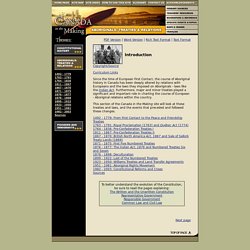
Furthermore, major and minor treaties played a significant and important role in charting the course of European - Aboriginal relations within the country. This section of the Canada in the Making site will look at these treaties and laws, and the events that preceded and followed these changes. First Nations Maps. First Nations map The Ontario First Nations map shows the locations of: First Nation communities: listed by band number and cultural affiliation (e.g., Algonquin, Cree, Ojibway) Tribal Councils (a grouping of bands with common interests who join together to provide advice and programs to their members) reserves (land set aside for bands under the Indian Act and treaty agreements) political organizations (e.g., Union of Ontario Indians, Grand Council Treaty 3) land covered by specific treaties The border shows symbols that have special meaning to First Nations in Ontario.
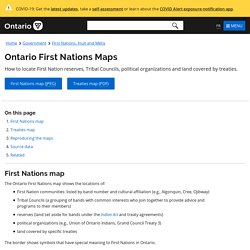
Websites and Open Resources - Indigenous Education K-12 - Research Guides at Lakehead University. First nations metis inuit studies grades 9 12. Guide for Lawyers Working with Indigenous Peoples may16. 9780774880213 Excerpt. Indigenous Laws and the Canadian Legal System - Aboriginal Law & Indigenous Laws - Research Guides at Queen's University. Making Space for Indigenous Law. CBA National - Canadian Legal Affairs. William Connolly was an apprentice clerk in the North West Company as the 19th century was dawning, embarking on a career in the fur trade that would let him die a wealthy man 62 years later.

At age 17 he met and married a Métis Cree girl named Miyo Nipiy, stepdaughter of an influential chief. They had six children together. In 1832, having clawed his way up the NWC corporate ladder, he moved to Montreal, disavowed his first marriage and married his second cousin in a Catholic church. After his death, his son by the first marriage sued for his inheritance — and won.
William Connolly’s chequered domestic history matters to us now for just one reason: it proves that in Canada, long after colonization was well advanced, Indigenous law and customs (marriage customs, for example) were alive enough to be seen by the courts as a valid body of common law. It’s an important point to remember as the reconciliation project moves forward. Still, the bylaw power isn’t useless. Aboriginal and Treaty Rights ~ Walking Together. Image Credits: Landscape backgrounds by season: Summer ©AP; Fall ©Kara Zutz 2011; Winter ©Iwona Erskin-Kelie, flickr 2009; Spring ©Ernie Zutz.
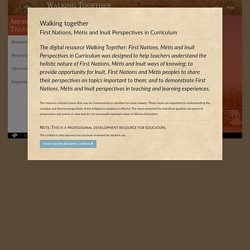
Voice Credits: Roy Louis, Josy Russel. Image Credits Beginning Together: Wetlands landscape ©Photodisc/Getty Images; Terry teacher image ©iStockPhoto.co. Voice Credits Beginning Together: Reflection statement: Donna Leask. Image Credits Beginning Together: Lesser Slave Lake beach ©Rob Irwin panoramio.com/photo/1227491, 2007; Teacher ©Kara Zutz. Voice Credits Beginning Together: "How the People Hunted the Moose" (told in Cree): Billy Joe Laboucan; "How the People Hunted the Moose" (told in English): Billy Joe Laboucan; "The Whiskey Jack's Coat" (told in French /Michif): T.J.
23 tips 1. eBooks. 7 First Nation Facts You Should Know. Here are seven First Nation facts plus one fun fact to add to your storehouse of knowledge. 1) Number of NationsThere are over 634 recognized First Nations governments or bands, roughly half of which are in the provinces of Ontario and British Columbia.
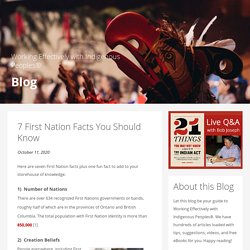
The total population with First Nation identity is more than 850,000 [1] 2) Creation Beliefs People everywhere, including First Nations, have their own creation beliefs. Each First Nation has its own creation beliefs, told in the form of a story of their ancestors. Essays on Canadian Law and Decolonization. PUBLIC EDUCATION. Publications. Canada in the Making - Aboriginals: Treaties & Relations. First Nations, Métis, and Inuit Studies.
Anishinaabe Art Eth Standards 4 Posters 11 x 17 EN. Presenting to First Nations Peoples. In this article, I’m going to provide some practical tips on what to do and what not to do for speakers/presenters who will be making presentations to audiences that include First Nations Peoples.

Why would I do this? I am routinely involved in conferences as a speaker, exhibitor, participant, and on occasion, as a conference organizer. I hear many speakers and a variety of presentation styles and can report that some speakers get it right, some make mistakes but manage to get along, and some don’t fair well at all. The speakers who do it well do protocol, use the correct and respectful terminology, and know what to say and what not to say. Those who struggle, and sometimes they don’t make it at all, struggle with one or all of the above. What follows are four tips to help you with your next presentation at an event that includes First Nations people in the audience. . #1: Words have impact. The first thing to know is that words have an impact on people. . #2: Get the terminology right. Reconciling Thanksgiving. “. . .

Reconciliation is about establishing and maintaining a mutually respectful relationship between Aboriginal and non-Aboriginal peoples in this country. In order for that to happen, there has to be awareness of the past, an acknowledgement of the harm that has been inflicted, atonement for the causes, and action to change behaviour.” [1] This article is intended to bring awareness to the past and provide “some food for thought” about the Thanksgiving narrative many of us have been raised to believe. Note: In this article, we use the term “tribes” as that is the terminology used in the United States. History lessons are increasingly being examined for narrative accuracy.
Walking Together. Image Credits: Landscape backgrounds by season: Summer ©AP; Fall ©Kara Zutz 2011; Winter ©Iwona Erskin-Kelie, flickr 2009; Spring ©Ernie Zutz.

Voice Credits: Roy Louis, Josy Russel. Guiding Voices Home Page. Historic, Legal and Contextual Background Information The reference terms and concepts explore legal and policy definitions; historical or contextual use of terminology; and concepts related to citizenship, culture and cultural repatriation, epistemologies and identity.

All terms and concepts presented here are for reference only to support building shared meaning and understanding about the criteria used in Guiding Voices. The inclusion of these terms and concepts is respectful of the diversity of identities of First Nations, Métis, Inuit, Aboriginal and Indigenous peoples, permitting them to self-identify in their own meaningful ways. Guide for Lawyers Working with Indigenous Peoples may16. Guide for Lawyers Working with Indigenous Peoples may16. Alan Hanna, “Spaces for Sharing: Searching for Indigenous Law on the Canadian Legal Landscape” - UBC Law Review Society. Indigenous Legal Traditions in Canada. Withorwithoutyou. Human aboriginal rights. Aboriginal and treaty rights powderface.
Royal Commission on Aboriginal Peoples - Library and Archives Canada. The Royal Commission on Aboriginal Peoples (RCAP) was established by Order in Council on August 26, 1991, and it submitted in October 1996 the Report of the Royal Commission on Aboriginal Peoples.
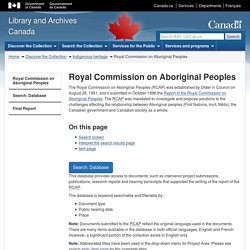
The RCAP was mandated to investigate and propose solutions to the challenges affecting the relationship between Aboriginal peoples (First Nations, Inuit, Métis), the Canadian government and Canadian society as a whole. On this page This database provides access to documents, such as intervenor project submissions, publications, research reports and hearing transcripts that supported the writing of the report of the RCAP. The database is keyword searchable and filterable by: Document type Public hearing date Place Note: Documents submitted to the RCAP reflect the original language used in the documents.
Note: Abbreviated titles have been used in the drop-down menu for Project Area. Search help Search screen Search by: Interpret the search results page Item Number Title Document Type Language. Truth, Reconciliation, and Accessibility: Canada’s Truth and Reconciliation Commission Reports in Accessible Formats. A total of 16 volumes, almost 8,000 pages of e-text, 600 hours of audio, and 6.75 gigabytes of information: every volume of the Truth and Reconciliation Commission’s reports on residential schools is now available for free and open download in e-text and Daisy audio formats. The French and English reports can be found by searching the NNELS site, or by visiting the NNELS TRC page. The Daisy versions of the reports are produced using synthetic narration and are full-text searchable using standard Daisy readers.
The reports are also available in PDF format from the National Centre for Truth and Reconciliation, and in print format from Lorimer (Executive Summary) and McGill-Queen’s University Press (Reports). Diana Davidson, Director of Alberta’s Public Library Services Branch, one of eight provincial and territorial NNELS partners, said, “NNELS is proud to be making these reports available to Canadians with print disabilities. Acknowledge Traditional Territories. Caut guide to acknowledging first peoples and traditional territory 2017 09. Decolonizing Pedagogies Booklet. Pulling Together: A Guide for Teachers and Instructors – Open Textbook. Pulling Together: A Guide for Teachers and Instructors – Open Textbook. Find Open Textbooks – BCcampus OpenEd Resources. Hair Colour for Hairstylists: Level 2Author(s): Arden Magtiza, Vancouver Island UniversityUpdated: Feb 19, 2021Description: This manual serves as a guide for apprentices with the desire to stretch beyond their foundational colour knowledge and skills so as to reach a higher level of competency.
This text will walk the stylist step-by-step through many current and advanced techniques used in the industry today. Accessible Elementary Algebra - 2e (OpenStax)Author(s): Lynn Marecek, Santa Ana College, MaryAnne Anthony-Smith, Formerly of Santa Ana College, Andrea Honeycutt Mathis, Northeast Mississippi Community CollegeUpdated: Feb 10, 2021Description: Elementary Algebra - 2e is designed to meet scope and sequence requirements for a one-semester elementary algebra course.
The book’s organization makes it easy to adapt to a variety of course syllabi. The text expands on the fundamental concepts of algebra while addressing the needs of students with diverse backgrounds and learning styles. Guiding Voices Home Page.